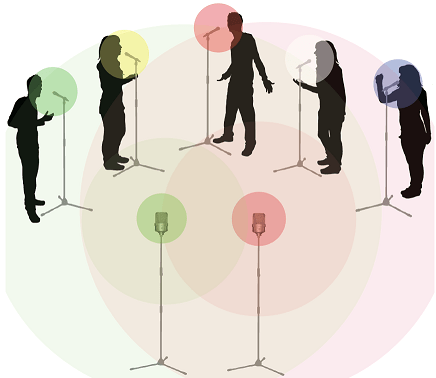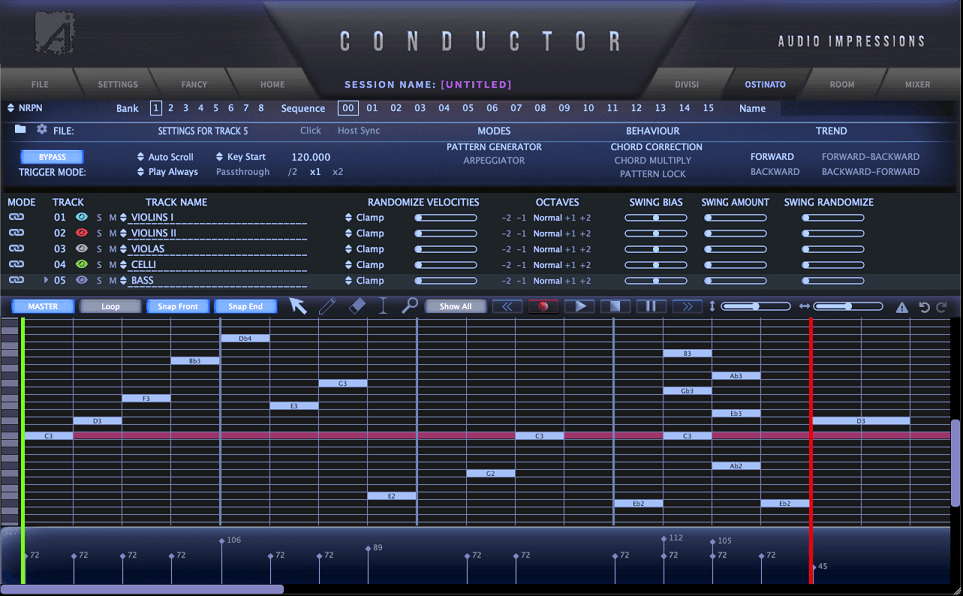Conductor
Extends the performance capabilities of any manufacturer’s virtual instruments in a single plug-in/standalone application.

Conductor is the framework where our patented processes interface. Conductor includes Divisi, The Room, Ostinato, Controllers and a Mixer.
The Mixer

Adjust the static audio output levels of your virtual instruments on the Mixer Page. You may also enable the ROOM button on each slider panel to create a new ball location on The Room’s virtual floor. Use our dial on the right, to raise or lower the sliders collectively without interfering with your relative mix.
The Room

Our patented microphone bleed simulator that recreates the interaction of multiple microphones (Spot Mics) during a recording session. The Room also recreates the separate room mics (Decca Tree) that capture the overall ensemble from a conductor’s perspective.
In addition to composing with virtual instruments, composers often overdub vocals and other solo instruments in their home studios. However, recording discrete instruments in a small recording room results in an unnatural “overdub” sound. The Room also packaged as a separate DAW plug-in for composers, musicians, and engineers wishing to recreate the sonic signature of a live ensemble recording environment with The Room.
In live ensemble recordings, each musician or group of musicians has a spot microphone closely in front of them. When the ensemble performs together, the sound of each instrument bleeds, in varying degree, into the mics of the other musicians. The farther apart the spot mics, the less mic bleed and proximity effect. The Room’s “Spot Mic Process” simulates this effect.

In addition to the various spot mics, it is also common to record the room sound with two or more room microphones placed at a moderate distance from the conductor’s perspective. The Room’s “Room Mic Process” also simulates the “Decca Tree” effect.
Ostinato

Our built-in MIDI Sequencer/Pattern Generator/Arpeggiator. It’s a companion to the Divisi page, because each Divisi System automatically has its own companion Ostinato instance, and each Divisi Stem has its own Ostinato Track. Ostinato tracks can be set with completely different patterns and behavior modes, or you can have one track that affects all Divisi stems simultaneously.
Controllers
Programmable Joysticks

Cross-blend up to 8 different MIDI plug-in instruments’ audio outputs, in real time, using the Joysticks panel control ball. The ball movements can also be captured and played back from your DAW track automation lanes.
Programmable Buttons

Conductor’s programmable buttons control MIDI switching. Switch articulations, trigger pattern generators, and Mute and Solo various instruments just like hardware controllers. Buttons are user-selectable in 10 button styles and 8 color choices.
Programmable Sliders

Conductor’s sliders control MIDI continuous controller functions. Adjust performance volume, vibrato, and timbre just like hardware controllers. Sliders are user-selectable, with 8 color choices for each slider.
Divisi
Add our patented Divisi process to all virtual instrument libraries and synths. You can also create Divisi ensembles, mixing different instrument families such as Strings, Winds and Brass. We offer three Divisi Processes: Standard Divisi, Swap Divisi, and String Instrument Divisi. Our Humanizer provides glissando, slurs, and more, for all virtual instruments.
Divisi allows string instrument sections to create an ideal sound-power balance. Since string instruments can’t play chords, each pitch of the chord must be distributed among players in the section.
Standard Divisi





A little-known practice outside of the string player community is called Soft-Attack Rejoins: When pitches of the chord are released, the players re-join with the remaining held pitches. String players naturally perform a fade-in on the re-join pitch. If they re-joined at full intensity, it would sound like an unwritten secondary attack.
Ai handles Soft Attack Rejoins with our patented Divisi Re-Join Smoothing Process.

Our Standard Divisi process can also be used to Divisi the entire string section, or any combination of instrument types.
Standard Divisi also incorporates our Humanize function which provides glissando and slurs, and more, for all virtual instruments. Playing a single note in Regular Divisi uses the same number of digital audio voices as there are instruments in the Divisi System all the time, thus the sound power balance remains the same, whether it is a single note or a full chord.
Swap Divisi
Our patented Swap Divisi process, addresses memory and CPU constraints. It creates Divisi with the same digital audio voice count as a regular virtual instrument. Swap Divisi is intended for basic musical applications such as chord pads.

For instance, when three pitches are played, an “A” section sounds the top pitch pitch, the Full Section sounds the middle pitch (attenuated -6 dB), and a “B” section sounds the lower pitch. There are more combinations such as when the lowest pitch is held while the upper pitches are let go, but this is the basic Swap Divisi process.
String Instrument Divisi
Our String Instrument Divisi process allows virtual string instruments to distribute the pitches of a chord across each individual string. This allows for proper chord voicing when played on a MIDI keyboard and provides a path for our pattern generator, “Ostinato” to generate realistic sounding guitar stums. It also allows future virtual string instrument libraries to have real-time control over which string plays a given passage.
